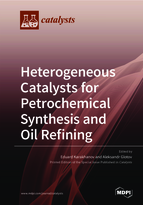Heterogeneous Catalysts for Petrochemical Synthesis and Oil Refining
A special issue of Catalysts (ISSN 2073-4344). This special issue belongs to the section "Industrial Catalysis".
Deadline for manuscript submissions: closed (30 November 2020) | Viewed by 22721
Special Issue Editors
Interests: petroleum chemistry; heterogeneous catalysis; oil refining; metal–organic frameworks; dendrimers; zeolites; structured mesoporous aluminosilicates; hydroformylation
Special Issues, Collections and Topics in MDPI journals
Interests: aluminosilicate nanotubes; zeolites; nanostructured mesoporous materials; aluminosilicate nanomaterials; catalytic cracking; hydroprocessing; isomerization
Special Issues, Collections and Topics in MDPI journals
Special Issue Information
Dear Colleagues,
Heterogeneous catalysis is among the major solutions for cost-effective and sustainable industrial application and processing. The design and development of highly efficient and stable heterogeneous catalysts represent an emergent frontier for overcoming energy and environmental challenges. Many industrial petrochemical and oil refining processes are faced with new challenges that can be solved using heterogeneous catalysts.
This Special Issue aims to cover the most recent progress and advances in the field of heterogeneous catalysts based on aluminosilicates, including zeolites and mesoporous materials, MOFs, COFs, and PAFs for petrochemical synthesis and oil refining. This includes but is not limited to hydroprocessing (including hydrotreating, isomerization, reforming, etc.), sulfur removal, catalytic cracking, C-1 chemistry, alcohols, fatty acids, and valuable chemicals synthesis.
Prof. Eduard Karakhanov
Dr. Aleksandr Glotov
Guest Editors
Manuscript Submission Information
Manuscripts should be submitted online at www.mdpi.com by registering and logging in to this website. Once you are registered, click here to go to the submission form. Manuscripts can be submitted until the deadline. All submissions that pass pre-check are peer-reviewed. Accepted papers will be published continuously in the journal (as soon as accepted) and will be listed together on the special issue website. Research articles, review articles as well as short communications are invited. For planned papers, a title and short abstract (about 100 words) can be sent to the Editorial Office for announcement on this website.
Submitted manuscripts should not have been published previously, nor be under consideration for publication elsewhere (except conference proceedings papers). All manuscripts are thoroughly refereed through a single-blind peer-review process. A guide for authors and other relevant information for submission of manuscripts is available on the Instructions for Authors page. Catalysts is an international peer-reviewed open access monthly journal published by MDPI.
Please visit the Instructions for Authors page before submitting a manuscript. The Article Processing Charge (APC) for publication in this open access journal is 2700 CHF (Swiss Francs). Submitted papers should be well formatted and use good English. Authors may use MDPI's English editing service prior to publication or during author revisions.
Keywords
- petrochemical synthesis
- oil refining
- zeolites
- aluminosilicates
- organic and metal–organic frameworks
- nanotubes
- hydroprocessing
- C-1 chemistry







